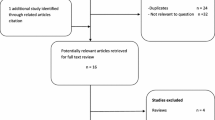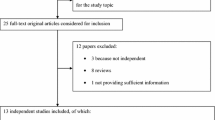Abstract
Purpose
Results from epidemiologic studies on coffee consumption and the risk of cutaneous melanoma are inconsistent. We conducted a meta-analysis to assess the associations between the consumption of total coffee, caffeinated coffee and decaffeinated coffee and the risk of cutaneous melanoma, respectively.
Methods
A literature search was performed in PubMed, Web of Science and EMBASE for relevant articles published up to August 2015. Pooled relative risks (RRs) with 95 % confidence intervals (CIs) were calculated with a random-effects model. Dose–response relationship was assessed by restricted cubic spline.
Results
Twelve studies involving 832,956 participants for total coffee consumption, 5 studies involving 717,151 participants for caffeinated coffee consumption and 6 studies involving 718,231 participants for decaffeinated coffee consumption were included in this meta-analysis. Compared with the lowest level of consumption, the pooled RRs were 0.80 (95 % CI 0.69–0.93, I 2 = 53.5 %), 0.85 (95 % CI 0.71–1.01, I 2 = 65.0 %) and 0.92 (95 % CI 0.81–1.05, I 2 = 0.0 %) for the consumption of total coffee, caffeinated coffee and decaffeinated coffee, respectively. In subgroup analysis by study design, the pooled RRs in cohort studies and case–control studies were 0.83 (95 % CI 0.72–0.97) and 0.74 (95 % CI 0.51–1.07) for total coffee consumption, respectively. Dose–response analysis suggested cutaneous melanoma risk decreased by 3 % [0.97 (0.93–1.00)] and 4 % [0.96 (0.92–1.01)] for 1 cup/day increment of total coffee and caffeinated coffee consumption, respectively.
Conclusions
This meta-analysis suggests that coffee consumption may reduce the risk of cutaneous melanoma.




Similar content being viewed by others
References
Giblin AV, Thomas JM (2007) Incidence, mortality and survival in cutaneous melanoma. J Plast Reconstr Aesthet Surg 60(1):32–40. doi:10.1016/j.bjps.2006.05.008
Leiter U, Eigentler T, Garbe C (2014) Epidemiology of skin cancer. Adv Exp Med Biol 810:120–140
SEER Stat Fact Sheets: Melanoma of the skin (2015). http://seer.cancer.gov/statfacts/html/melan.html
Cho E, Rosner BA, Feskanich D, Colditz GA (2005) Risk factors and individual probabilities of melanoma for whites. J Clin Oncol 23(12):2669–2675. doi:10.1200/JCO.2005.11.108
Gandini S, Sera F, Cattaruzza MS, Pasquini P, Picconi O, Boyle P, Melchi CF (2005) Meta-analysis of risk factors for cutaneous melanoma: II. Sun exposure. Eur J Cancer 41(1):45–60. doi:10.1016/j.ejca.2004.10.016
Song F, Qureshi AA, Gao X, Li T, Han J (2012) Smoking and risk of skin cancer: a prospective analysis and a meta-analysis. Int J Epidemiol 41(6):1694–1705. doi:10.1093/ije/dys146
Zhang YP, Chu RX, Liu H (2014) Vitamin A intake and risk of melanoma: a meta-analysis. PLoS One 9(7):e102527. doi:10.1371/journal.pone.0102527
Nkondjock A (2009) Coffee consumption and the risk of cancer: an overview. Cancer Lett 277(2):121–125. doi:10.1016/j.canlet.2008.08.022
Lu Y, Zhai L, Zeng J, Peng Q, Wang J, Deng Y, Xie L, Mo C, Yang S, Li S, Qin X (2014) Coffee consumption and prostate cancer risk: an updated meta-analysis. Cancer Causes Control 25(5):591–604. doi:10.1007/s10552-014-0364-8
Zhou Q, Luo ML, Li H, Li M, Zhou JG (2015) Coffee consumption and risk of endometrial cancer: a dose-response meta-analysis of prospective cohort studies. Sci Rep 5:13410. doi:10.1038/srep13410
Tian C, Wang W, Hong Z, Zhang X (2013) Coffee consumption and risk of colorectal cancer: a dose-response analysis of observational studies. Cancer Causes Control 24(6):1265–1268. doi:10.1007/s10552-013-0200-6
Sang LX, Chang B, Li XH, Jiang M (2013) Consumption of coffee associated with reduced risk of liver cancer: a meta-analysis. BMC Gastroenterol 13:34. doi:10.1186/1471-230X-13-34
Fortes C, Mastroeni S, Boffetta P, Antonelli G, Pilla MA, Botta G, Anzidei P, Venanzetti F (2013) The protective effect of coffee consumption on cutaneous melanoma risk and the role of GSTM1 and GSTT1 polymorphisms. Cancer Causes Control 24(10):1779–1787. doi:10.1007/s10552-013-0255-4
Green A, Bain C, McLennan R, Siskind V (1986) Risk factors for cutaneous melanoma in Queensland. Recent Results Cancer Res 102:76–97
Loftfield E, Freedman ND, Graubard BI, Hollenbeck AR, Shebl FM, Mayne ST, Sinha R (2015) Coffee drinking and cutaneous melanoma risk in the NIH-AARP diet and health study. J Natl Cancer Inst. doi:10.1093/jnci/dju421
Naldi L, Gallus S, Tavani A, Imberti GL, La Vecchia C, Oncology Study Group of the Italian Group for Epidemiologic Research in D (2004) Risk of melanoma and vitamin A, coffee and alcohol: a case–control study from Italy. Eur J Cancer Prev 13(6):503–508
Nilsson LM, Johansson I, Lenner P, Lindahl B, Van Guelpen B (2010) Consumption of filtered and boiled coffee and the risk of incident cancer: a prospective cohort study. Cancer Causes Control 21(10):1533–1544. doi:10.1007/s10552-010-9582-x
Osterlind A, Tucker MA, Stone BJ, Jensen OM (1988) The Danish case–control study of cutaneous malignant melanoma. IV. No association with nutritional factors, alcohol, smoking or hair dyes. Int J Cancer 42(6):825–828
Veierod MB, Thelle DS, Laake P (1997) Diet and risk of cutaneous malignant melanoma: a prospective study of 50,757 Norwegian men and women. Int J Cancer 71(4):600–604
Wu H, Reeves KW, Qian J, Sturgeon SR (2015) Coffee, tea, and melanoma risk among postmenopausal women. Eur J Cancer Prev 24(4):347–352. doi:10.1097/CEJ.0000000000000093
Wu S, Han J, Song F, Cho E, Gao X, Hunter DJ, Qureshi AA (2015) Caffeine intake, coffee consumption, and risk of cutaneous malignant melanoma. Epidemiology. doi:10.1097/EDE.0000000000000360
Glass GV (1976) Primary, secondary, and meta-analysis of research. Educ Res 5:3–8
Yew YW, Lai YC, Schwartz RA (2015) Coffee consumption and melanoma: a systematic review and meta-analysis of observational studies. Am J Clin Dermatol. doi:10.1007/s40257-015-0165-1
Larsson SC, Orsini N (2011) Coffee consumption and risk of stroke: a dose-response meta-analysis of prospective studies. Am J Epidemiol 174(9):993–1001. doi:10.1093/aje/kwr226
DerSimonian R, Laird N (1986) Meta-analysis in clinical trials. Control Clin Trials 7(3):177–188
Higgins JP, Thompson SG (2002) Quantifying heterogeneity in a meta-analysis. Stat Med 21(11):1539–1558. doi:10.1002/sim.1186
Higgins JP, Thompson SG, Deeks JJ, Altman DG (2003) Measuring inconsistency in meta-analyses. BMJ 327(7414):557–560. doi:10.1136/bmj.327.7414.557
Higgins JP, Thompson SG (2004) Controlling the risk of spurious findings from meta-regression. Stat Med 23(11):1663–1682. doi:10.1002/sim.1752
Patsopoulos NA, Evangelou E, Ioannidis JP (2008) Sensitivity of between-study heterogeneity in meta-analysis: proposed metrics and empirical evaluation. Int J Epidemiol 37(5):1148–1157. doi:10.1093/ije/dyn065
Tobias A (1999) Assessing the influence of a single study in the meta-analysis estimate. Stata Tech Bull 47:15–17
Egger M, Davey Smith G, Schneider M, Minder C (1997) Bias in meta-analysis detected by a simple, graphical test. BMJ 315(7109):629–634
Orsini N, Li R, Wolk A, Khudyakov P, Spiegelman D (2012) Meta-analysis for linear and nonlinear dose-response relations: examples, an evaluation of approximations, and software. Am J Epidemiol 175(1):66–73. doi:10.1093/aje/kwr265
Harrell FE Jr, Lee KL, Pollock BG (1988) Regression models in clinical studies: determining relationships between predictors and response. J Natl Cancer Inst 80(15):1198–1202
Orsini N, Bellocco R (2006) Generalized least squares for trend estimation of summarized dose–response data. Stata J 6:40–57
Jackson D, White IR, Thompson SG (2010) Extending DerSimonian and Laird’s methodology to perform multivariate random effects meta-analyses. Stat Med 29(12):1282–1297. doi:10.1002/sim.3602
Lu YP, Lou YR, Peng QY, Xie JG, Conney AH (2004) Stimulatory effect of topical application of caffeine on UVB-induced apoptosis in the epidermis of p53 and Bax knockout mice. Cancer Res 64(14):5020–5027. doi:10.1158/0008-5472.CAN-04-0760
Lu YP, Lou YR, Xie JG, Peng QY, Zhou S, Lin Y, Shih WJ, Conney AH (2007) Caffeine and caffeine sodium benzoate have a sunscreen effect, enhance UVB-induced apoptosis, and inhibit UVB-induced skin carcinogenesis in SKH-1 mice. Carcinogenesis 28(1):199–206. doi:10.1093/carcin/bgl112
Gude RP, Menon LG, Rao SG (2001) Effect of Caffeine, a xanthine derivative, in the inhibition of experimental lung metastasis induced by B16F10 melanoma cells. J Exp Clin Cancer Res 20(2):287–292
Tsuchiya H, Tomita K, Yasutake H, Ueda Y, Tanaka M, Sasaki T (1989) Growth inhibition and differentiation of murine melanoma B16-BL6 cells caused by the combination of cisplatin and caffeine. Jpn J Cancer Res 80(12):1246–1251
Denkert C, Kobel M, Berger S, Siegert A, Leclere A, Trefzer U, Hauptmann S (2001) Expression of cyclooxygenase 2 in human malignant melanoma. Cancer Res 61(1):303–308
Goulet AC, Einsphar JG, Alberts DS, Beas A, Burk C, Bhattacharyya A, Bangert J, Harmon JM, Fujiwara H, Koki A, Nelson MA (2003) Analysis of cyclooxygenase 2 (COX-2) expression during malignant melanoma progression. Cancer Biol Ther 2(6):713–718
Kang NJ, Lee KW, Shin BJ, Jung SK, Hwang MK, Bode AM, Heo YS, Lee HJ, Dong Z (2009) Caffeic acid, a phenolic phytochemical in coffee, directly inhibits Fyn kinase activity and UVB-induced COX-2 expression. Carcinogenesis 30(2):321–330. doi:10.1093/carcin/bgn282
Lee KA, Chae JI, Shim JH (2012) Natural diterpenes from coffee, cafestol and kahweol induce apoptosis through regulation of specificity protein 1 expression in human malignant pleural mesothelioma. J Biomed Sci 19:60. doi:10.1186/1423-0127-19-60
Lee KJ, Jeong HG (2007) Protective effects of kahweol and cafestol against hydrogen peroxide-induced oxidative stress and DNA damage. Toxicol Lett 173(2):80–87. doi:10.1016/j.toxlet.2007.06.008
Munafo MR, Flint J (2004) Meta-analysis of genetic association studies. Trends Genet 20(9):439–444. doi:10.1016/j.tig.2004.06.014
Urgert R, van der Weg G, Kosmeijer-Schuil TG, van de Bovenkamp P, Hovenier R, Katan MB (1995) Levels of the cholesterol-elevating diterpenes cafestol and kahweol in various coffee brews. J Agric Food Chem 43:2167–2172
Ratnayake WM, Hollywood R, O’Grady E, Stavric B (1993) Lipid content and composition of coffee brews prepared by different methods. Food Chem Toxicol 31(4):263–269
IARC Working Group (1991) Coffee, tea, mate, methylxanthines and methylglyoxal. IARC Working Group on the Evaluation of Carcinogenic Risks to Humans. Lyon, 27 February to 6 March 1990. IARC Monogr Eval Carcinog Risks Hum 51:1–513
Author information
Authors and Affiliations
Corresponding author
Ethics declarations
Conflict of interest
On behalf of all authors, the corresponding author states that there is no conflict of interest.
Electronic supplementary material
Below is the link to the electronic supplementary material.
Supplementary Fig. 1
The funnel plot of total coffee consumption and the risk of cutaneous melanoma Each dot represents a different study. (EPS 2813 kb)
Rights and permissions
About this article
Cite this article
Wang, J., Li, X. & Zhang, D. Coffee consumption and the risk of cutaneous melanoma: a meta-analysis. Eur J Nutr 55, 1317–1329 (2016). https://doi.org/10.1007/s00394-015-1139-z
Received:
Accepted:
Published:
Issue Date:
DOI: https://doi.org/10.1007/s00394-015-1139-z




